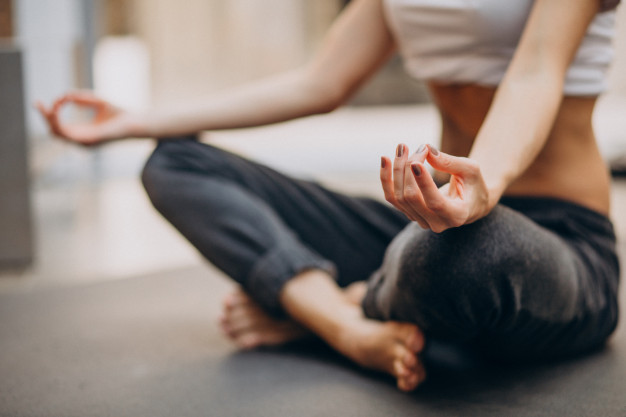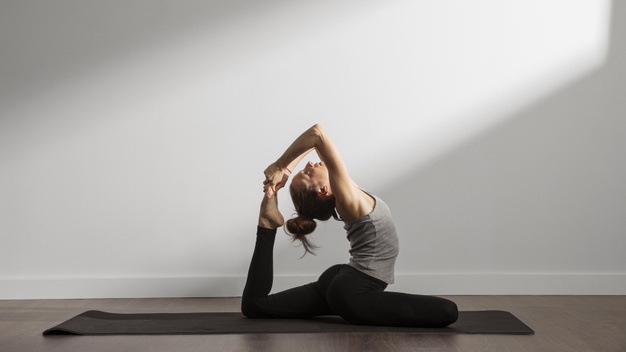An ancient art that is over 5000 years old is once again gaining worldwide popularity. Yoga, the art of science and wellness that was given to the world by India has gained a massive following in advanced western countries.
It is an art and science that pushes human beings to go back to their roots and look within to find solutions to problems. Yoga is an all-inclusive model of development for both, mental as well as physical well-being.
If you are someone that is familiar with Yoga or has been struggling with mental health issues, you would have heard about the term- Cortisol. This is a hormone that leads to negative thoughts, insecurities, and stress. This is the ‘Stress Hormone’.
Science has shown that practicing Yoga for as little as fifteen minutes a day can help reduce the amount of Cortisol that is secreted by your brain. In this article, we look at the seven benefits of a daily at-home yoga practice. We speak to leading experts at a black owned yoga studio and requested them to help us come up with the list of benefits.
Yoga: A Proven Ancient Science or something simply concocted out of thin air?
First things first. Before we get to the list of benefits, let us try and address an issue that critics of Yoga have been vehemently espousing for many years.
The first mention of Yoga as a form of health and wellness can be found in ancient texts that are over five thousand years old. The evidence of Yoga has been documented by academicians and historians in the Harappan and Indus Valley civilizations.
It has for the last few decades helped millions over the world deal with the following issues-
- Combat stresses, anxiety, and depression.
- Build better health of internal organs.
- Create a Positive Outlook towards life.
- Improve Focus, Attention, and Concentration.
- Strengthen the Core and Muscles and Joints.
In short, Yoga has nothing but positive effects on the human body. It is a breathing exercise, meditation, and physical regimen all built into one.
List of 7 Benefits of a Daily At-Home Yoga Practice:
1. The Greatest Asset to Fight Mental Health Issues-
Most medical experts point out that the breathing exercises that are a major part of Yoga help relieve tensions, stresses, and anxieties. This helps ward off negative energies, creates positive thoughts, and diminishes the hormone Cortisol production. Practicing Yoga for 15 minutes a day can be the best bet to fight and prevent mental health issues from emerging.
2. Builds Core Strength and Improves Flexibility-
A lot of Yoga is improving the core strength of your body. This is not some muscle like a bicep or triceps. The closest you can start to compare this with the Shaolin Monks and their level of mental toughness. The flexible nature of the exercises when doing Yoga can help in muscle strengthening, conditioning, and improving joints and other connective tissues’ health.
3. Helps in Improving Digestion and Food Absorption-
Stress is a major factor that affects digestion. IBS or Irritable Bowel Syndrome is something that a majority of professionals face. Doing Yoga regularly can help improve the digestion system of the body.
It can help in the positive absorption of food, minerals, and vitamins into the body. Just fifteen minutes of regular Yoga can help achieve a lot in this regard.
4. Lead to Weight Reduction in Obese Individuals-
Obesity is one of the most dangerous illnesses currently affecting western developed countries. While going for strict diet regimens and sweating it out at the gym are options, Yoga should be tried as a great alternative strategy. Studies and trials have shown that Yoga through controlling the brain and the body can help in weight reduction in a major way.
5. Helps in Boosting Energy Levels within the Body-
I am sure most of us have felt out of breath and energy even after waking up from an entire night of sleep. When you start doing Yoga, you will realize that your energy levels are always at an optimum. The reason for the same is that Yoga helps create energy by channeling positivity from the brain and the body. This helps boost productivity and help in success.
6. Improves Sleeping Patterns and Counters Insomnia-
Insomnia is a clear and pressing issue of our times. Poor mental health is one of the major factors that trigger insomnia. With Yoga, you will be able to improve the sleeping patterns. Yoga is based heavily on breathing exercises. With the right flow of oxygen into the body, sleep gets positively impacted. The clear mind and brain also help massively.
7. Wards off Diseases and Infections and help stay healthy-
Yoga has been found to have a lot of positive effects in strengthening the Immune System of the body. It can help one stay healthy and ward off normal infections and diseases. At the end of the day falling ill is a function of a weak immune system. Regularly doing Yoga can help an individual to stay healthy for long periods and avoid falling sick all the time.
The Final Word:
You do not have to slog countless hours in a yoga studio to enjoy all the benefits that have been listed above. All you need to do is find an expert practitioner that understands your issues and can devise a Yoga regimen that best suits you.
The key is to be regular when it comes to Yoga. You cannot expect immediate results. It is slow, yet the detailed process that is more a way of living than a quick fix solution.
With the Coronavirus pandemic causing everyone to stay indoors, the best Yoga centers are coming up with at-home sessions that you can safely do and enjoy from the comfort and safety of your home. All you need to do is fix a session, join it via a Zoom link and follow what the trainers are doing. This is a simple and effective way to stay in tune with Yoga in the changed situation we are living in.
Read Also:
























